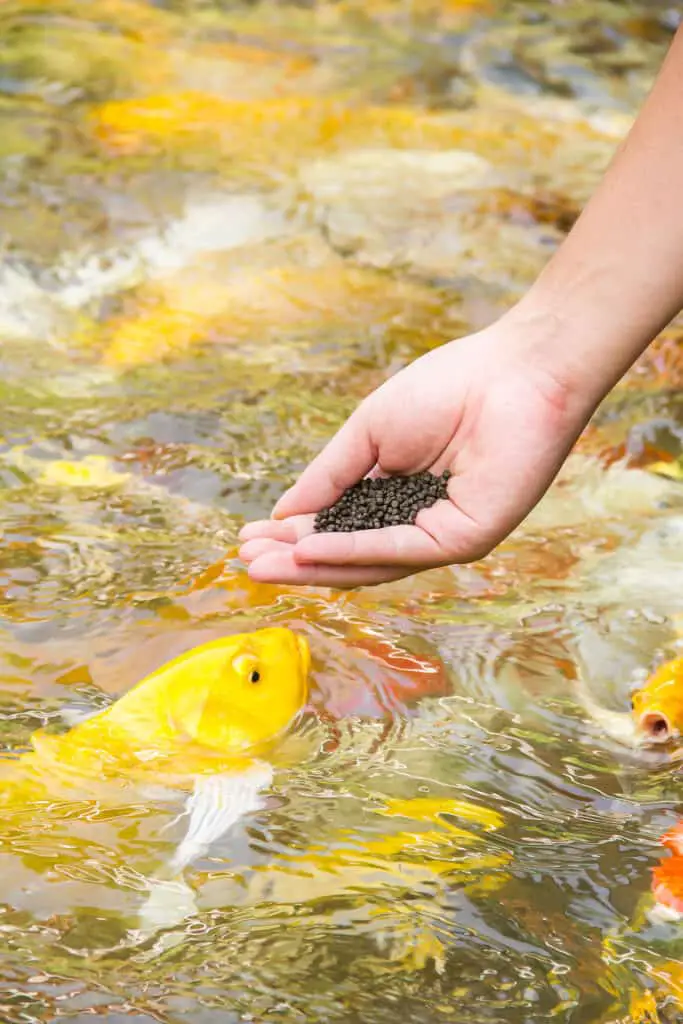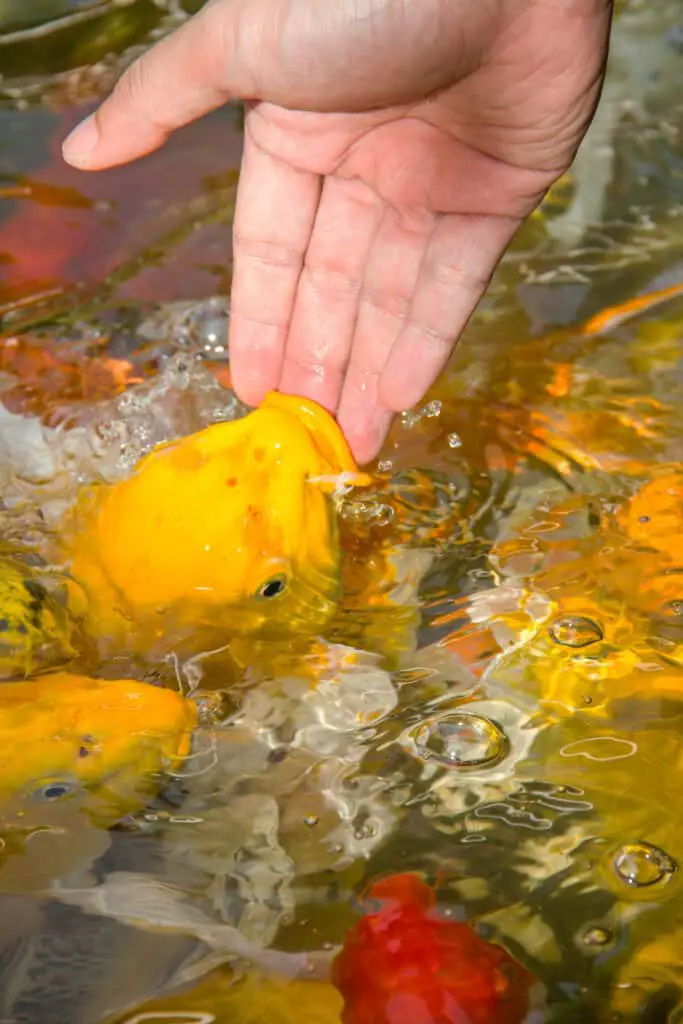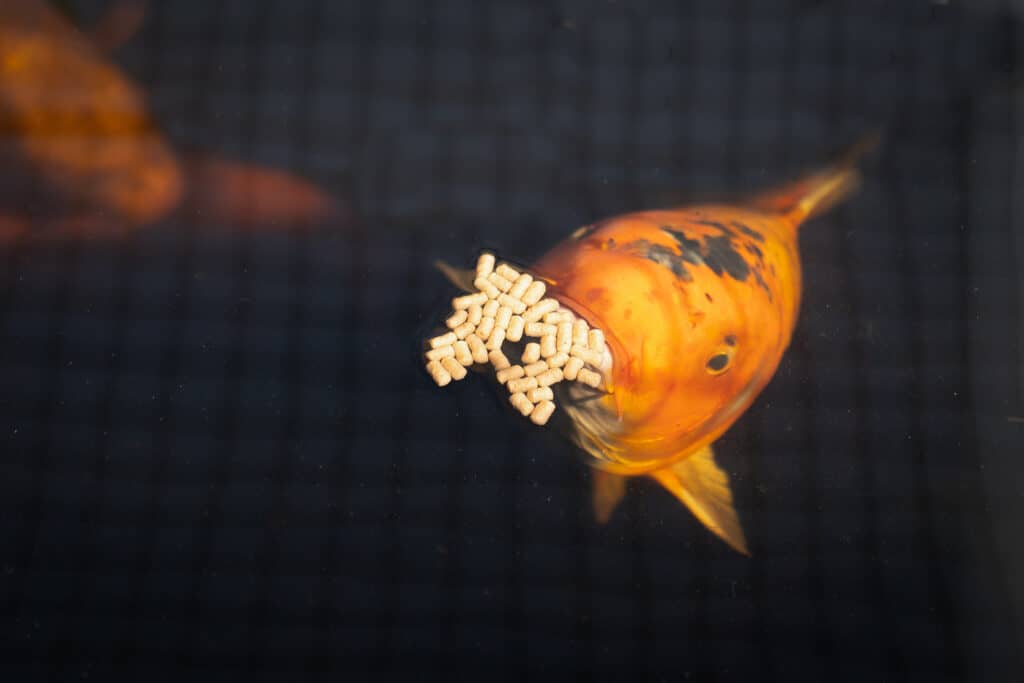
If you have many koi fish, you may find that buying koi food in bulk is more convenient and economical. However, you might wonder how long koi food lasts and if it expires. We had the same question and decided to do some research to help answer how long koi fish food lasts. This is what we discovered.
Koi food lasts for up to six months before the nutrients in the food start to deteriorate. Most koi food has an expiration date on the package. This should be used as a guideline to determine when the koi food has expired. Expired koi food has lower nutritional value and shouldn’t be fed to koi.
You might think it’s fine to feed koi expired food, as most koi food comes in dry form. However, you might also be wondering if koi food does actually expire and if there are any dangers to feeding your koi expired food. We will answer these questions and then share some tips for extending the shelf life of your koi food.
Pro Tip: If you’re tired of wasting money and making costly mistakes on the koi-keeping hobby or are thinking about buying koi fish but don’t know where to start, I strongly suggest you check out this ebook. I recently read this ebook, and it contains SO much useful information, such as:
- 3 proven steps to identify koi fish diseases
- WARNING: 3 things you should NEVER do when it comes to caring for koi
- When to seek professional help when it comes to looking after your koi
Does Koi Food Really Expire?

Koi are fed various food types, from dry fish pellets to frozen blood worms and insects. Most food koi are fed will have an expiration date written on the packaging. However, as these foods are preserved, you might think that they don’t really expire. Unfortunately, this is not true.
Koi food has a limited shelf life. As the food gets older, it starts losing some nutritional value and becomes less beneficial for your koi. Old koi food can also cause algae overgrowth in your pond or aquarium and might lead to cloudy water. Therefore, feeding old koi food to your koi is not recommended.
Most koi experts say that koi food only lasts about six months in dry form. This might sound like an extremely short period. However, the koi food is still safe to feed the koi after six months. While the food doesn’t go bad or become harmful to your fish after six months, it does start losing some of its nutritional value.
The quality of koi food starts decreasing after six months, and at twelve months, the food has significantly fewer nutrients than it did when you first opened it. Experts recommend not feeding your koi food older than eighteen months, as this food will have almost no nutritional value.
Therefore, it is safe to assume that koi food lasts about six months to a year and expires eighteen months after production. This is also when the label will indicate an expiration date. Apart from the nutritional value of koi food decreasing, other factors come into play when koi food gets older.
1. The Koi Food Becomes Less Palatable
If you’ve ever eaten old cereal, you’ll understand what this means. Even when the food has not expired yet, older koi food will become less palatable, and the koi won’t enjoy eating it as much. If the koi don’t want to eat the food, their condition will deteriorate, and some fish may even die.
This is another problem with the decreased nutritional value of old koi food. The koi fish don’t get enough nutrients and may be susceptible to pests, disease, and other koi-related health problems. Therefore, it is best to feed your koi only the freshest food.
2. Expired Koi Food Can Become Rancid
Koi need a diet high in macronutrients (protein, fats, and carbs). If you feed koi fish dry food, it will contain some fats. Fat becomes rancid when it expires and will give the food a foul smell and taste. This will discourage the koi from eating it and might make the koi that do eat the rancid pellets sick.
Never feed koi food that smells bad or has an odd color or texture. These are indicators that the food is spoilt, which should be discarded rather than fed to the koi.
3. Old Koi Food Can Develop Mold
Mold can start to grow on koi food as it gets older. When the koi food is exposed to air, it also gets exposed to moisture, which can cause mold to grow on the food. Mold can be hazardous to koi fish and can potentially kill them.
Therefore, you must always inspect opened koi food for mold or traces of mold. Suppose the food looks like it might have mold, discard it immediately.
These are the top three things that can happen when koi food gets old and expires. While not all these factors can kill koi fish, they can lead to them becoming unhealthy and failing to thrive. Therefore, avoid feeding koi fish expired food at all costs.
If you prefer buying food in bulk, there are some ways of extending the food’s shelf life, ensuring you don’t have to toss any koi food because it has gone bad.
How To Extend Koi Food’s Shelf Life

When attempting to extend the shelf life of koi food, you must remember to limit the amount of light, heat, and oxygen the food is exposed to. These factors will lead to the food going bad quicker. However, you can successfully extend its shelf life by storing the koi food in a cool and dry place.
The following tips are handy if you buy koi food in bulk and want to preserve the food once it has been opened. This is how to extend koi food’s shelf life and prevent the food from going bad.
1. Store Koi Food In An Airtight Container
Oxygen exposure can lead to mold growing on koi food and the fat going rancid. Therefore, keeping the koi food in an airtight container, such as a zip-lock bag or plastic container, can protect the food from extended oxygen exposure.
Once the koi food has been opened, transfer it to an airtight container to extend the shelf life to keep it fresh for longer. This will prevent the food from going bad and ensure the food tastes good and the nutrients don’t decrease.
2. Keep Koi Food Away From Sunlight
Sunlight may cause condensation and sweat in the koi food packaging. Warm, moist packages provide the perfect environment for mold and bacteria to grow. This will lead to your koi food becoming rancid or developing mold, forcing you to discard it.
However, storing the koi food in a place out of sunlight can prevent the food from developing mold or bacteria and extend its shelf life.
3. Store Koi Fish Food In A Cool, Dry Place
Heat will also cause mold to grow on koi food and might cause the fat in the koi food to go rancid. Moisture, as we explained above, also leads to mold growth. Therefore, keep the koi food in a cool, dry spot to prevent it from going bad.
To extend the shelf life of koi food, you can also store it in a refrigerator or freezer. There, the food will be protected from mold or bacteria, and the nutritional value of the food will remain intact. Even though these methods can help prevent koi food from going bad, you should still aim to use the koi food before its expiration date. If the food smells or looks odd, don’t feed it to your koi.
Conclusion
Koi food, even in dry pellet form, can expire. Koi food lasts surprisingly short. Within six months, the koi food will start to lose some nutritional value, and within eighteen months, no nutrients will be left in the food. In addition, mold can grow on the food, and the fats in the pellets can go rancid.
Therefore, always check the expiry date of koi food and don’t feed your koi expired food. Keep opened koi food in a cool, dry spot and store it in an airtight container to prevent the food from going bad.
References
https://www.plantedtank.net/threads/safe-to-use-expired-fish-food.1295797/


